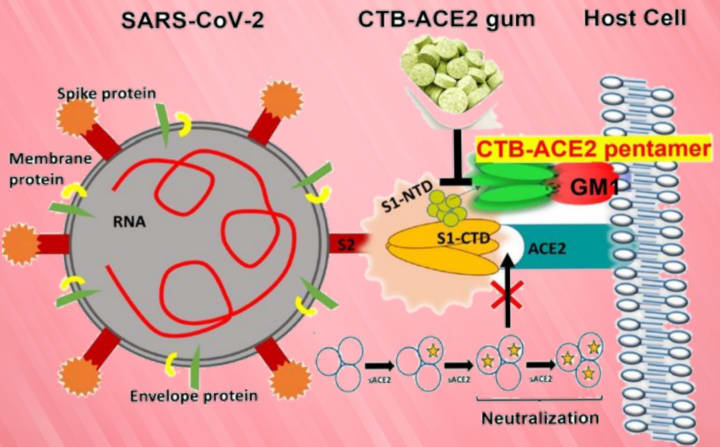Chewing Gum With Protein That "Traps" the SARS-CoV-2 Virus Developed That Could Reduce COVID Transmission
According to a new study, chewing gum coated with a plant-grown protein acts as a "trap" for the SARS-CoV-2 virus, lowering viral load in saliva and potentially slowing transmission.

The research, led by Henry Daniell of Penn's School of Dental Medicine and carried out in collaboration with scientists from Penn's Perelman School of Medicine and School of Veterinary Medicine, as well as The Wistar Institute and Fraunhofer USA, could lead to a low-cost tool in the COVID-19 pandemic's arsenal. The results of their research were published in the journal Molecular Therapy.
"SARS-CoV-2 replicates in the salivary glands, and we know that when an infected person sneezes, coughs, or talks, some of the virus is released and spread to others," Daniell explains. "This gum gives us a simple technique to maybe cut down on a source of disease transmission by neutralizing the virus in the saliva."
COVID-19 vaccines have helped to alter the trajectory of the epidemic, but they haven't completely stopped it. Even persons who have been fully vaccinated can contract SARS-CoV-2 and, according to new studies, have a viral load similar to those who have not been immunized.

Daniell had been researching the angiotensin-converting enzyme 2 (ACE2) protein in the perspective of treating hypertension prior to the pandemic. His group has used a patented plant-based production technology to generate this protein, as well as a number of others with therapeutic potential. They urge plant chloroplasts to take up the DNA and begin developing the proteins by bombarding plant material with the DNA of target proteins. The plant material, which has been freeze-dried and crushed up, might be employed to deliver the protein. This approach has the potential to overcome one of the most common roadblocks to protein medicine development: an expensive manufacturing and purifying process.
Daniell's previous work on ACE2 came at a good time during the COVID-19 epidemic. On human cells, the ACE2 receptor also binds the SARS-CoV-2 spike protein. Injections of ACE2 have been proven to lower viral load in persons with severe illnesses by other research groups.
Meanwhile, Daniell and her Penn Dental Medicine colleague Hyun (Michel) Koo have been working on developing a chewing gum packed with plant-grown proteins to help break up dental plaque. Daniell wondered if a gum injected with plant-grown ACE2 proteins may neutralize SARS-CoV-2 in the oral cavity, combining his knowledge of ACE2 with this technology.
To discover out, he contacted Ronald Collman, a virologist and pulmonary and critical care doctor at Penn Medicine, whose team had been collecting blood, nasal swabs, saliva, and other biospecimens from COVID patients for scientific research since the early stages of the pandemic.

Collman says, "Henry called me and asked whether we had samples to test his approach, what kind of samples would be appropriate to test, and whether we could internally validate the level of SARS-CoV-2 virus in the saliva samples." "As a result of our microbiome research, we formed a cross-school collaboration."
To test the chewing gum, the researchers produced ACE2 in plants and combined it with another component that allows the protein to pass mucosal barriers and aids binding, then put the plant material into cinnamon-flavored gum tablets. They demonstrated that the ACE2 present in nasopharyngeal swabs from COVID-positive individuals might kill SARS-CoV-2 viruses by incubating them with the gum.
Others at The Wistar Institute and Penn Vet followed up with studies in which viruses that were less pathogenic than SARS-CoV-2 were engineered to express the SARS-CoV-2 spike protein. The gum primarily stopped viruses or viral particles from entering cells, either by blocking the ACE2 receptor on the cells or by binding directly to the spike protein, according to the researchers.
Finally, the researchers exposed saliva samples from COVID-19 patients to the ACE2 gum and discovered that viral RNA levels dropped to practically undetectable levels.
The research team is currently seeking to gain approval to perform a clinical trial to see if the technique is safe and successful in persons who have been infected with SARS-CoV-2.
"Henry's idea of producing proteins in plants and ingesting them is low-cost and, hopefully, scalable; it's incredibly ingenious," Collman says.
Though the study is still in its early phases, if clinical studies show that the gum is safe and effective, it might be given to patients whose infection status is unknown, or even for dental check-ups when masks must be removed, to limit the risk of the virus being passed to caretakers.
"We're already utilizing masks and other physical barriers to prevent transmission," Daniell explains. "This gum could be an additional weapon in the battle."
About the Creator
chamila herath
Public relations and communications expert with a strategic mindset who has worked in corporate communications, producing and pitching news releases, editorials, strategic planning, and public opinion management.
Enjoyed the story? Support the Creator.
Subscribe for free to receive all their stories in your feed. You could also pledge your support or give them a one-off tip, letting them know you appreciate their work.






Comments
There are no comments for this story
Be the first to respond and start the conversation.